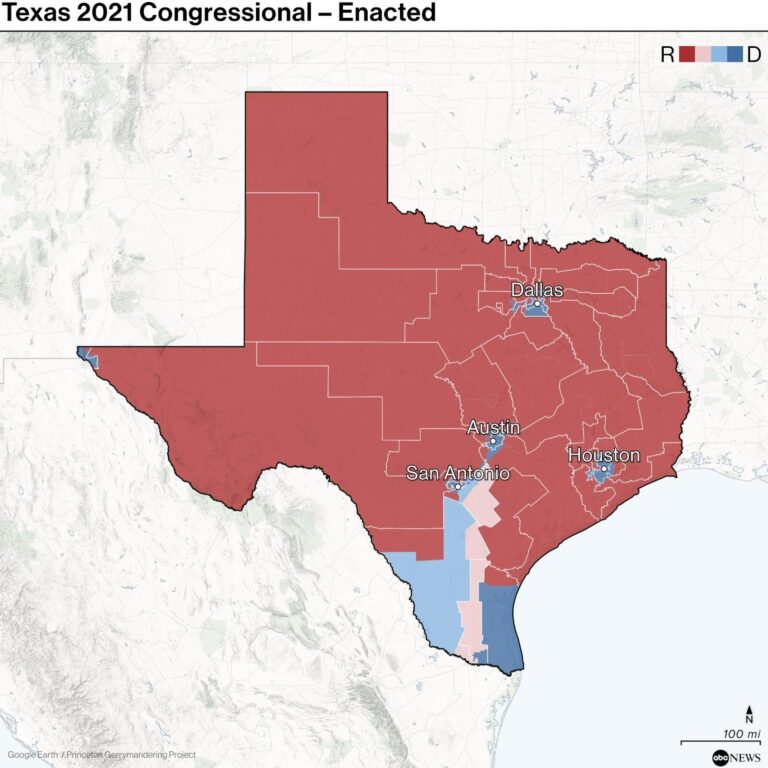Texas GOP’s Redistricting Plan: A Strategic Shift Targeting Democratic Bases
Republican Redistricting Tactics Aim to Reshape Texas Political Map
The Texas Republican Party has introduced a comprehensive redistricting proposal designed to alter the state’s political terrain by focusing on traditionally Democratic areas. This plan seeks to fragment established Democratic districts, thereby weakening their electoral influence and creating more advantageous conditions for Republican candidates. Such a move challenges existing district boundaries and ignites debates about the integrity of voter representation and electoral fairness.
Key elements of this redistricting strategy include:
- Dividing densely populated urban centers with strong Democratic support into multiple districts that lean Republican.
- Integrating suburban and rural regions with conservative majorities to counterbalance Democratic voter concentrations.
- Utilizing detailed demographic analytics to pinpoint precincts susceptible to boundary adjustments.
| District | Current Political Lean | Projected Post-Redistricting Lean |
|---|---|---|
| Houston 7 | Strongly Democratic | Highly Competitive |
| Dallas 32 | Democratic | Republican-Leaning |
| Austin 25 | Democratic | Lean Democratic |
Legal Battles and Political Consequences of the New District Maps
The proposed redistricting by Texas Republicans has triggered a surge of legal disputes, spotlighting the tension between political maneuvering and equitable voter representation. Opponents contend that the new maps constitute overt partisan gerrymandering aimed at diminishing Democratic influence in key metropolitan and suburban districts. Civil rights organizations have filed lawsuits alleging violations of the Voting Rights Act, arguing that the redistricting dilutes minority voting power and threatens decades of progress toward electoral fairness. The state judiciary now faces the critical task of determining whether these changes violate constitutional protections or fall within legislative authority.
Beyond legal scrutiny, the political ramifications are profound. Redrawing district lines will not only influence the immediate election outcomes but also reshape the balance of power within Texas and on the national stage. Analysts observe an escalation in partisan conflict as Republicans seek to strengthen their control over the state legislature and congressional delegation. The table below illustrates the anticipated shifts in seat distribution based on the proposed boundaries:
| Party | Current Seats | Projected Seats | Net Change |
|---|---|---|---|
| Republicans | 23 | 27 | +4 |
| Democrats | 13 | 9 | -4 |
- Potential federal intervention if discriminatory redistricting is confirmed.
- Voter confusion risks due to abrupt changes in district boundaries before elections.
- National ripple effects as Texas’s approach may influence redistricting battles across other states.
Community Perspectives: The Impact on Voter Representation and Engagement
Local leaders and activists have voiced strong opposition to the redistricting proposals, emphasizing the threat to historically Democratic neighborhoods’ political influence. Many residents feel marginalized, concerned that the division of their communities into multiple districts will fragment their collective voting power. This fragmentation risks undermining equitable representation and weakening democratic participation in Texas.
Grassroots organizations stress the importance of preserving districts that honor shared cultural, geographic, and socioeconomic ties. They warn that the redistricting plan jeopardizes:
- Minority voting strength, which depends on maintaining unified electoral districts.
- Community involvement in elections, as divided districts often experience reduced voter turnout.
- Effective policy advocacy, where representatives can better address the needs of cohesive constituencies.
| Community Concern | Effect on Voter Representation |
|---|---|
| District Fragmentation | Diminishes unified voting influence |
| Minority Vote Dilution | Reduces likelihood of electing preferred candidates |
| Lower Voter Participation | Decreases political engagement and accountability |
Advocacy Approaches to Safeguard Equitable Districting
Opponents of the Texas redistricting plan are employing a multifaceted strategy emphasizing transparency, legal recourse, and community involvement. Central to their efforts is the push for independent redistricting commissions to replace partisan map drawing, aiming to reduce political bias. Public education initiatives and grassroots mobilization play a vital role, equipping voters with clear data visualizations and platforms to express concerns about proposed changes.
Legal challenges remain a critical component, with civil rights advocates compiling evidence to contest unfair district maps in court. Complementing litigation, advocates focus on:
- Vigilant monitoring of legislative sessions to anticipate and respond to new proposals.
- Partnerships with national watchdog groups to access resources and expertise.
- Advocacy for robust federal oversight to ensure compliance with voting rights protections.
| Advocacy Strategy | Purpose |
|---|---|
| Independent Commissions | Create impartial bodies for drawing district maps |
| Litigation | Challenge partisan maps through the judicial system |
| Community Engagement | Inform and involve voters in the redistricting process |
| Federal Oversight | Enforce adherence to the Voting Rights Act |
Final Thoughts: The High Stakes of Texas Redistricting
The ongoing redistricting debate in Texas highlights the intense struggle over political power and voter representation. The Republican-led effort to redraw districts targeting Democratic bases underscores the critical importance of fair electoral maps in shaping governance. With significant legal challenges underway and community opposition mounting, the outcome of this battle will have lasting effects on Texas’s political future and may set influential precedents for redistricting efforts nationwide. As the state moves closer to upcoming elections, all eyes remain fixed on how these changes will redefine the democratic landscape.







